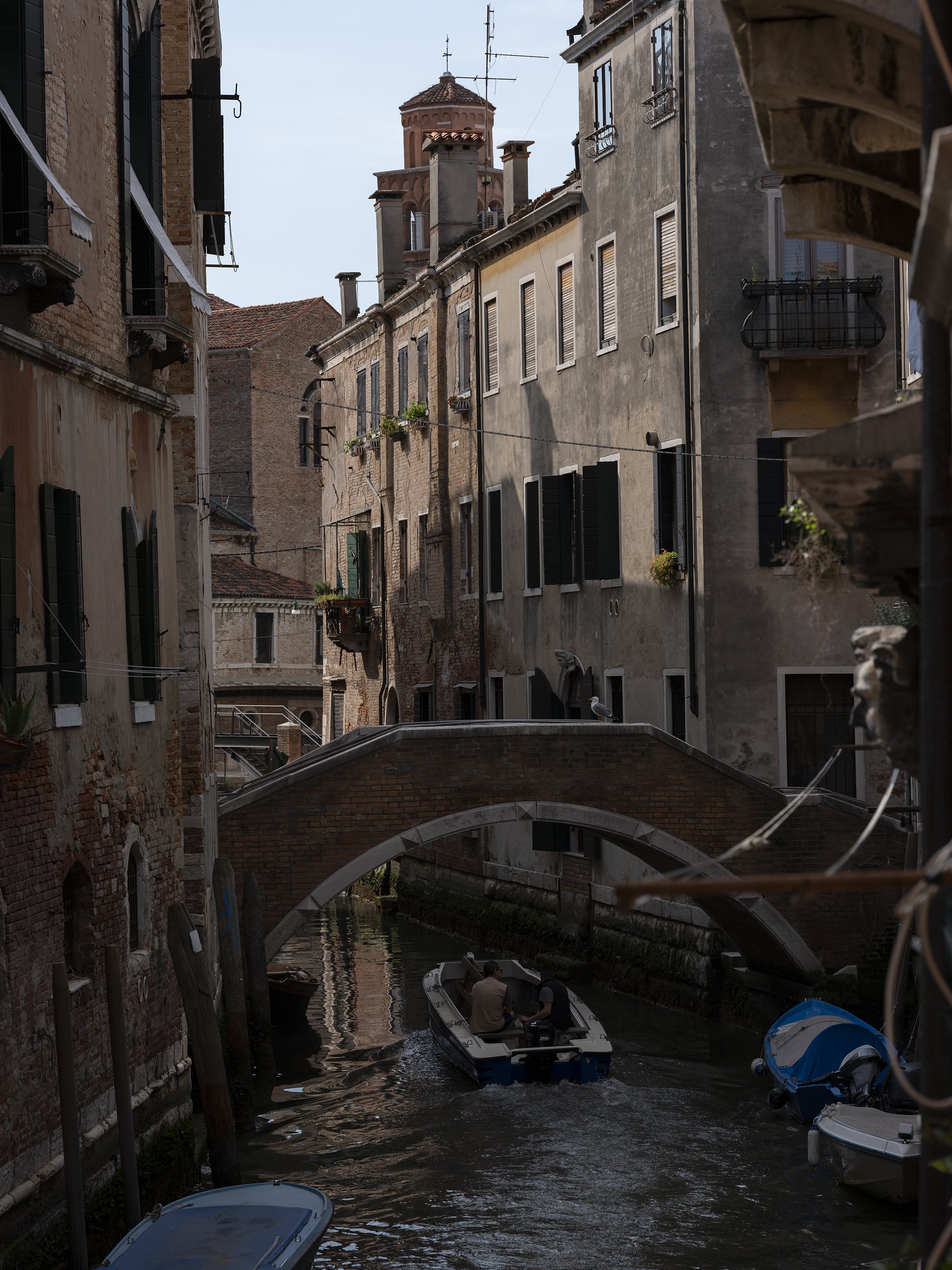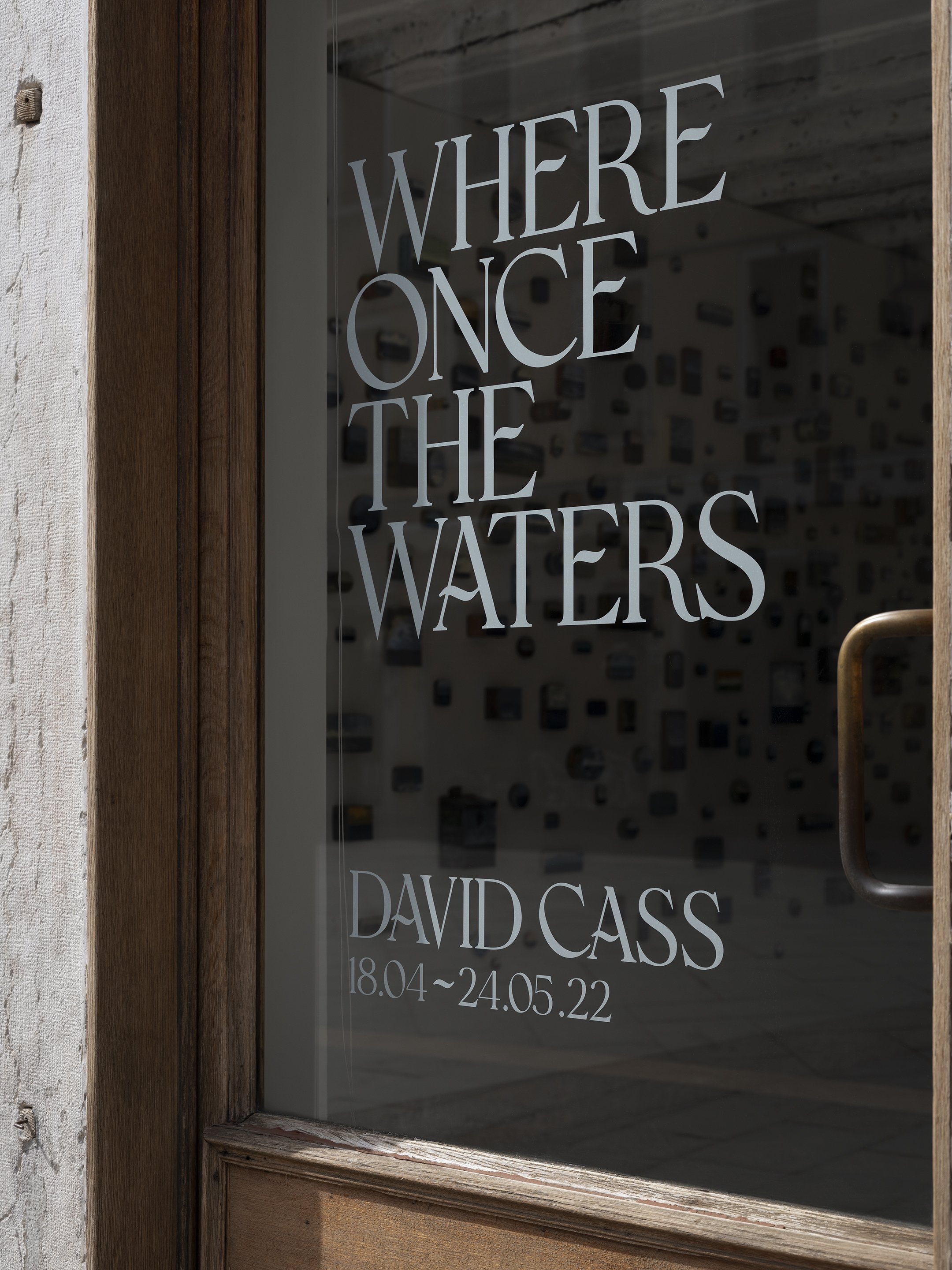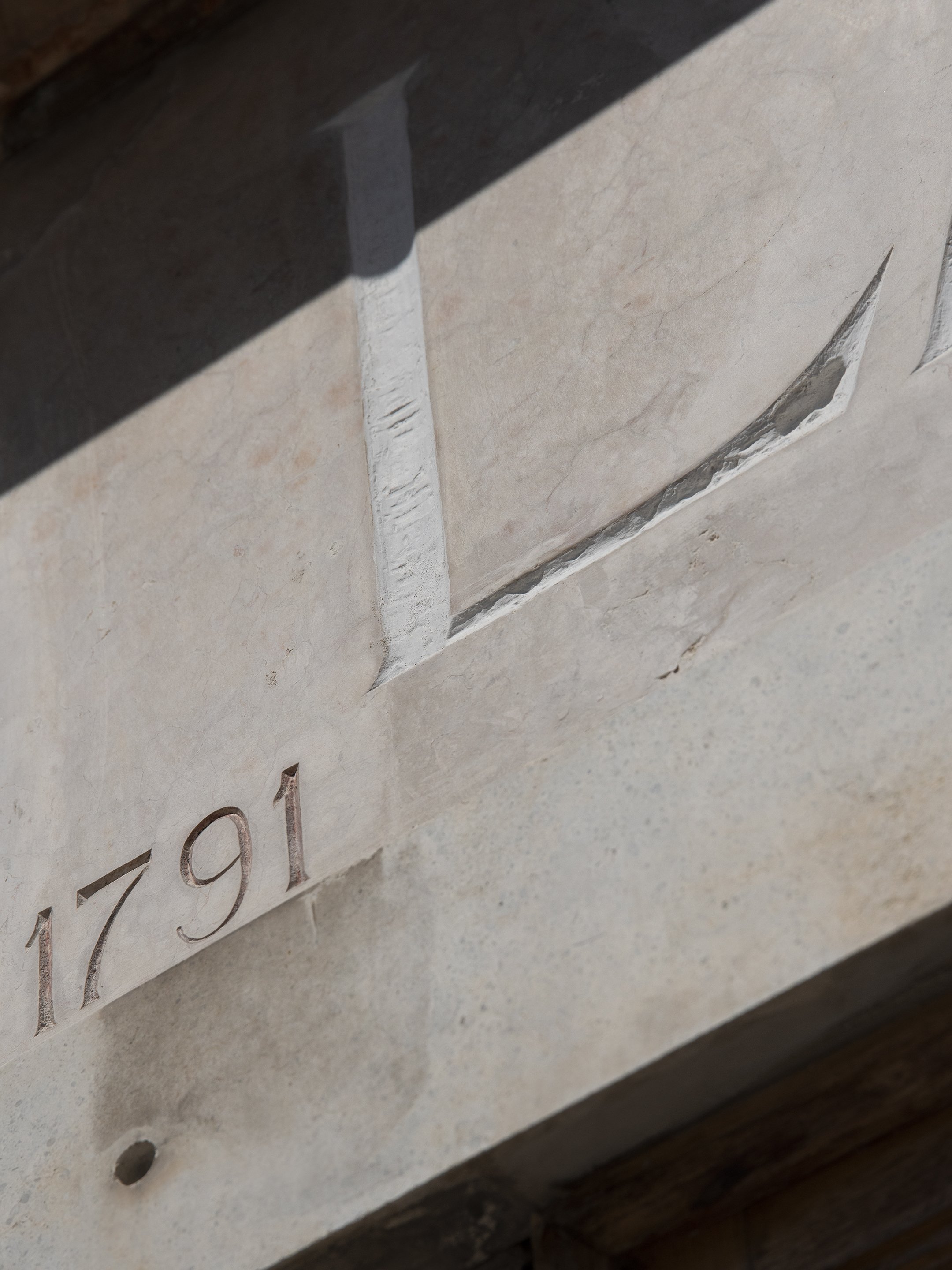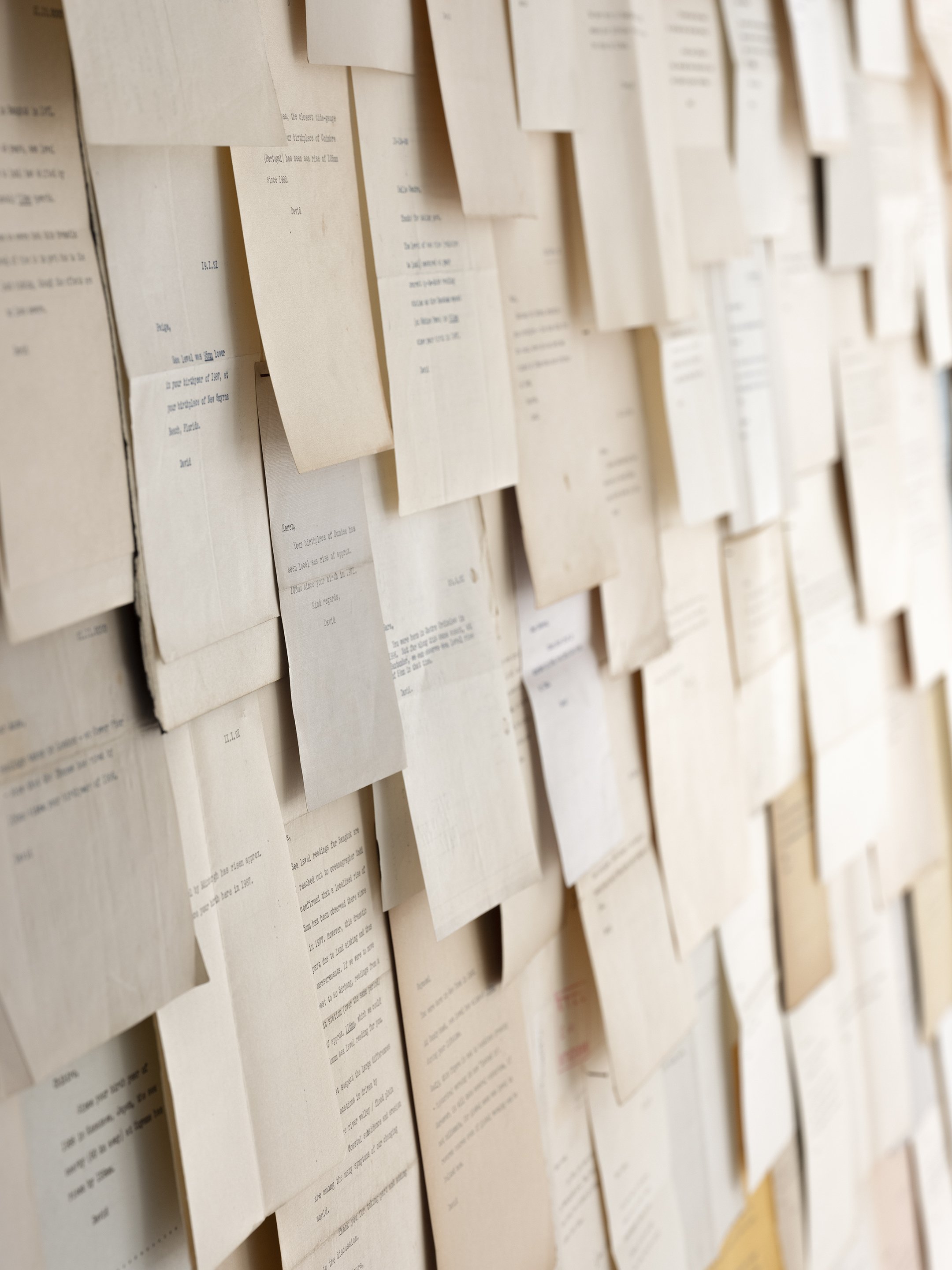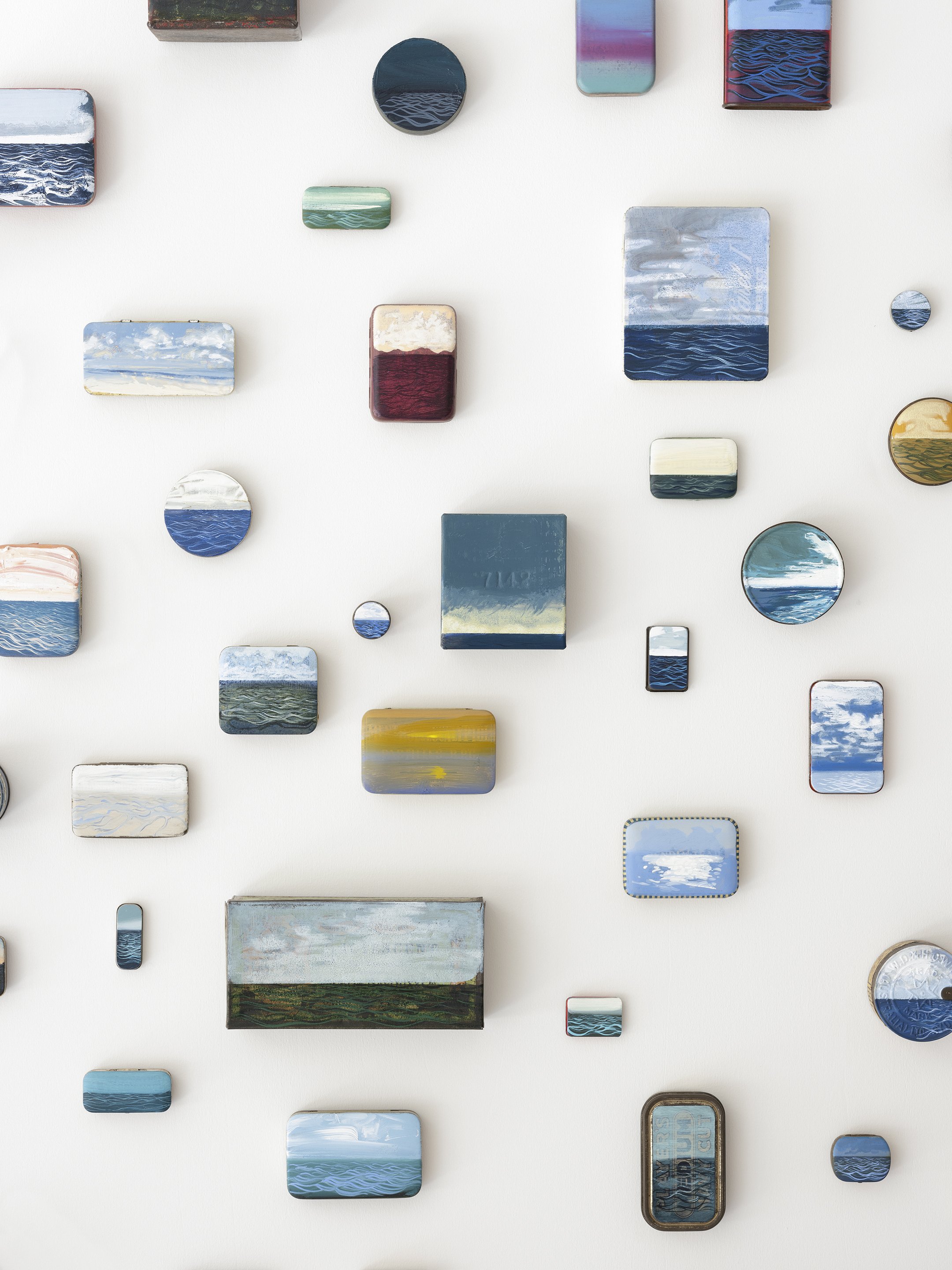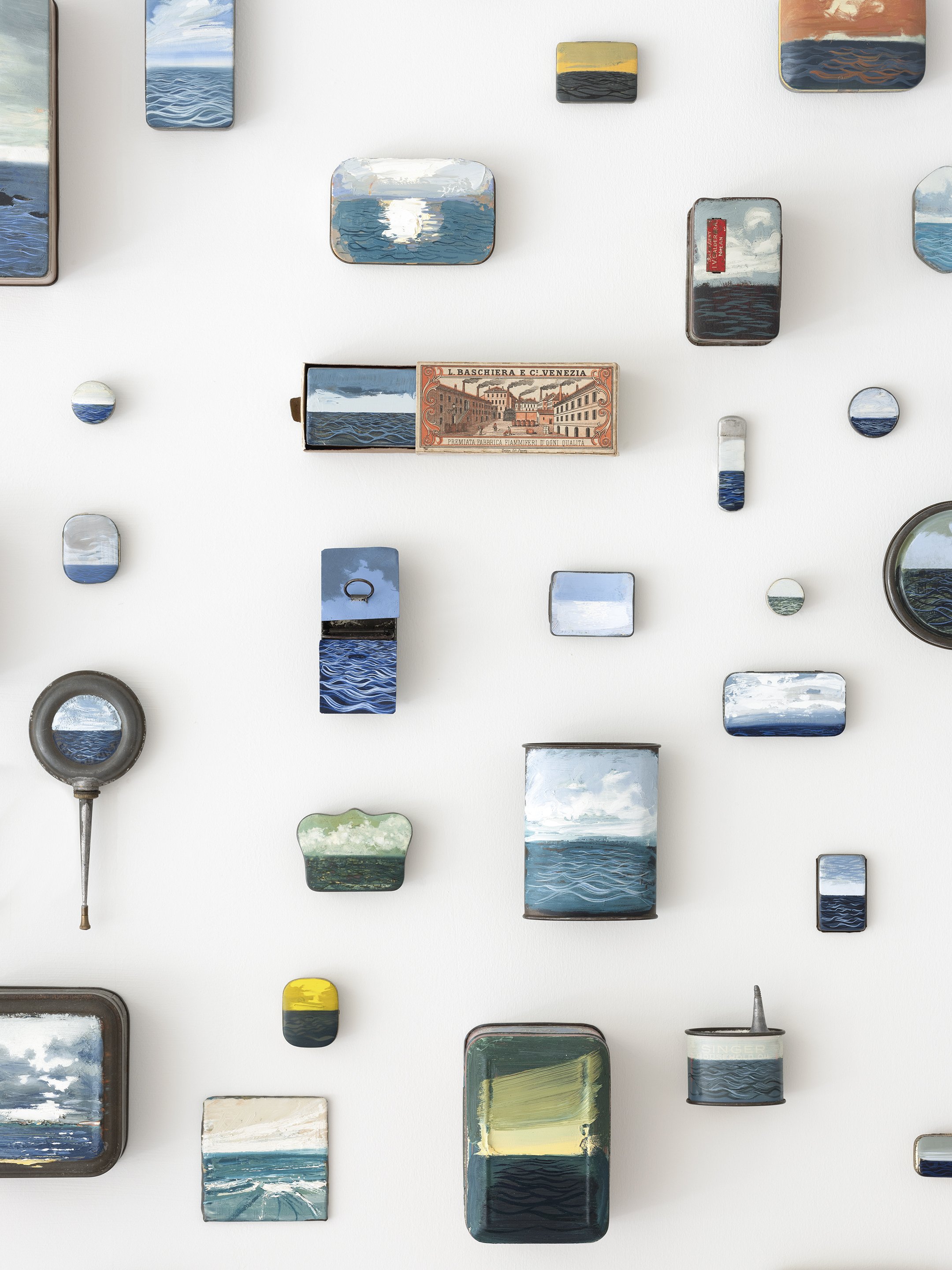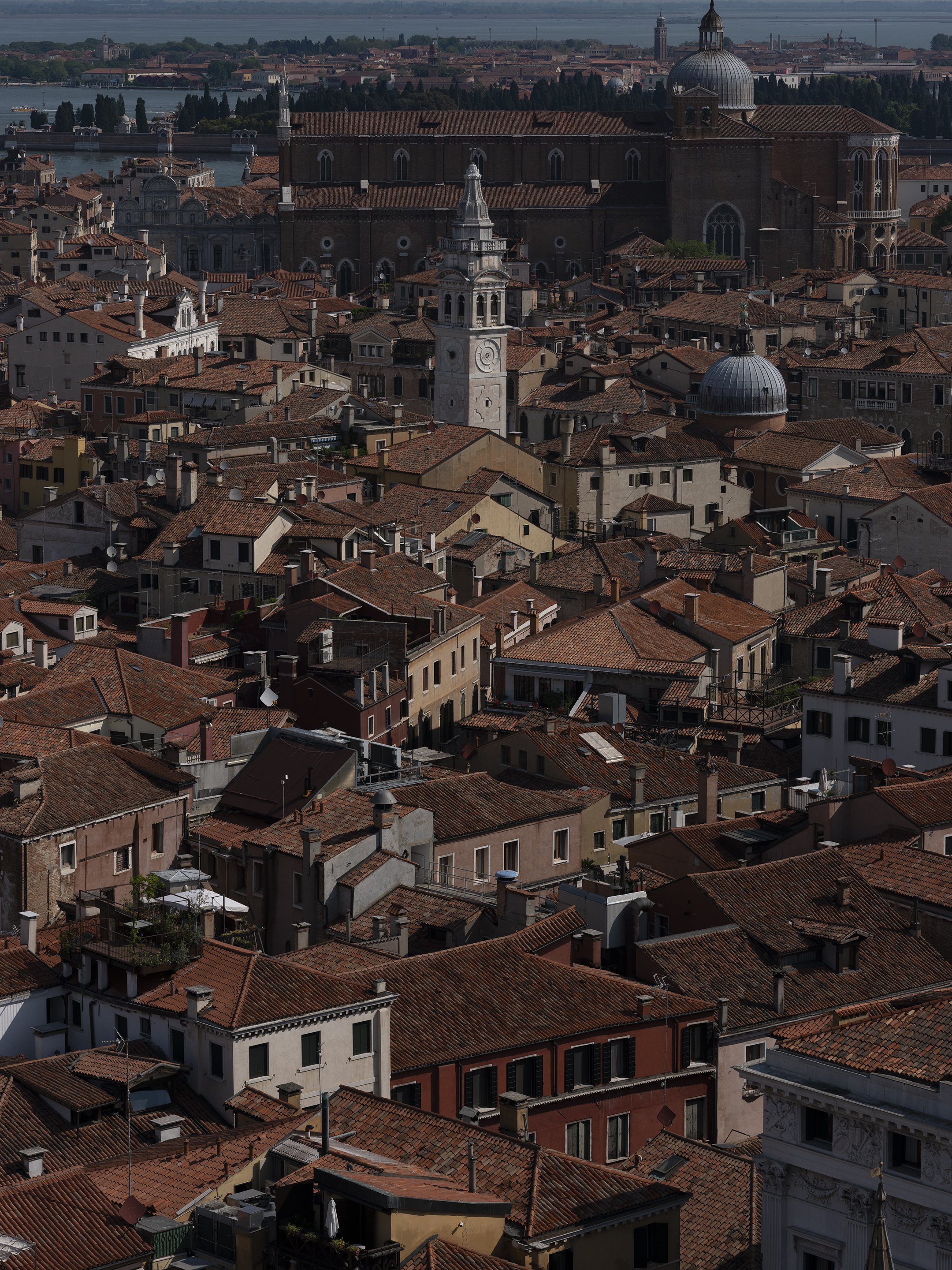
Where Once the Waters was originally comprised of two artwork sets: a series of typed letter-artworks, still ongoing; and a collection of miniature seascape paintings, now completed. The works principally address the issue of rising sea levels, inviting the viewer to reflect on changes which have occurred across their lifetimes, whilst offering commentary on sustainability. An exhibition during the 59th Venice Biennale saw the two sets exhibited together for the first and only time. Since then, several exhibitions have included the artworks separately. Today, the letter-artworks continue to be exhibited regularly, most recently in Reykjavík and London; and currently in the Royal Scottish Academy, Edinburgh. You can take part at any time.
Series I · Letters exhibited in Venice
Installation designed by David Cass (2018) & written 2020–2022
Researched by a small team listed in the exhibition book
Typed & reviewed by Cass & Becky Campbell
Found papers between ~25 & 250 years old
Series II · 365 days exhibited in Venice
Installation designed by David Cass (2017)
Painted 2018–2022
Found antique metal tins & boxes up to ~130 years old
Series I · Letters exhibited in Concord, MA
Installation designed by David Cass (2018) & written 2020–2023
Typed & reviewed by Cass & Campbell
Found papers between ~25 & 250 years old
David Cass (b. 1988, Edinburgh) is an artist best known for his environmentally themed projects using found and recycled materials. His subject over the last decade has been the sea, and in recent years, the issue of sea rise. We know that sea levels around the world are climbing. However, due to various factors, the rate of rise from coast to coast is not even. Some locations are experiencing more dramatic fluctuations in sea level and more frequent inundation.
The two polyptychs presented during Cass’ 2022 Biennale exhibition illustrated our changing sea. On one gallery wall, the artist presented 365 painted metal tins – a snapshot of a year at sea – while the wall opposite this explored a longer timeframe, telling us through a series of typed letters, how much the seas nearest our birthplaces have risen during our lifetimes.*
Today, almost 1000 letters have been produced to form this principal artwork, speaking of coastlines retreating, eroding, sinking and even lifting, offering figures (measurements) we can visualise, often because the level of change described might be contained within the sheet of paper the letter is typed upon. Knowing what is happening at coastlines we are connected to allows us to engage with a topic so often shrouded in complex science, or average global figures not specific to any one place.
While the artist has typed onto the ephemeral paperwork of life: correspondences, birth certificates, documents, wills, deeds; he has painted onto the seemingly insignificant objects we’ve lived with. In these pieces, the artist has used small, overlooked items, yet those which are integral parts of everyday living. Here, Cass has described a shifting horizon line – using that division between sea and sky to indicate fluctuations in water level. The decision to paint 365 references this period of record-breaking annual ocean temperatures.
Both works in this evolving project invite the viewer in. They speak personally to us, perhaps hoping that by offering points of entry and accessible data, a globally significant issue might be brought home.
*Please note that this is a creative project – it does not aim to offer scientific guidance
David Cass (nato nel 1988, Edimburgo) è un artista conosciuto soprattutto per i suoi progetti a tema ambientale che utilizzano materiali ritrovati e riciclati. Il suo soggetto principale nell'ultimo decennio è stato il mare e, più recentemente, la questione dell'innalzamento del suo livello. Il livello del mare in tutto il mondo sta salendo. Tuttavia, a causa di vari fattori, il tasso di aumento da costa a costa non è uniforme. Alcune località – Venezia, ad esempio – stanno vivendo fluttuazioni più drammatiche ed inondazioni più frequenti.
Su due pareti, le due opere presentate in questa mostra si univano per illustrare un mare mutevole. Mentre le 365 lattine di metallo su questa parete potevano essere l'istantanea dipinta di un anno in mare, la parete di fronte esplorava un lasso di tempo più lungo, suggerendoci di quanto i mari più vicini ai nostri luoghi di nascita sono aumentati nel corso della nostra vita.*
Composto da ~1000 lettere dattiloscritte, il progetto parlava di coste che si ritirano, si erodono, sprofondano e, addirittura, si sollevano. Le lettere aiutavano a visualizzare numeri, spesso perché il livello di cambiamento del mare è comparabile al foglio di carta su cui la lettera stessa è scritta. Sapere cosa sta succedendo sulle coste a cui siamo connessi ci consente di interessarci in un argomento così spesso avvolto in una scienza complessa.
Mentre l'artista ha dattiloscritto sulle scartoffie effimere della vita: corrispondenze, certificati di nascita, testamenti, atti; egli ha dipinto sugli oggetti apparentemente insignificanti con cui abbiamo vissuto. Ha scelto oggetti piccoli e trascurati, ma vitali per la nostra vita quotidiana. In questa serie, Cass, ha semplicemente dipinto una linea di orizzonte mutevole – usando quella divisione tra mare e cielo per indicare le fluttuazioni del livello dell'acqua.
In entrambe le opera, Cass invitava gli spettatori ad entrare, parlando direttamente con noi, auspicando forse che offrendo punti d’accesso e dati comprensibili, si poteva dar risalto ad una questione significativa per tutto il mondo. “La mostra rende concreto il nostro bisogno di significato, il nostro bisogno di proteggere una delicata simbiosi con il pianeta,” scrive la storica dell’arte Patricia Emison. La mostra è chiusa, ma il progetto continua.

“Always, and unremittingly, the sea is now political. It is not just part of our society but of our bodies. It has a voice that must be heard as we seek alternatives to the unconstrained violence of growth-based economics. Every way in which we now threaten the sea’s delicate balance will haunt our species and all others for millennia. Damage the ocean, and we destroy ourselves. There is no better distillation of these messages and their aesthetic power than the art of David Cass. The urgency of his message has prompted rich interweaving of visual and textual components to generate visions that no one medium could communicate alone.”
On two walls, two oceans…
Kate Reeve-Edwards on the Venice Biennale Exhibition | Spring 2022
One, a rippling anthology of 600 letters, cresting on the breeze from an open door. The other, a swell of 365 different seas, sounds, gulfs, bays and channels, painted onto repurposed vintage tins.
Both pieces hold a shared narrative: a love letter to our oceans, a plea to respond to rising sea levels.
Both walls are created from a plethora of minute, individual narratives. Each letter contains a story of sea rise mapped across the participants’ lifetimes. Each painting contains a different body of water, where the horizon line, time of day, and weather conditions vary in every unique view.
Both forms are containers. The tins, receptacles for past objects and vessels for new painted histories. The letters, capsules of time and tidelines, likewise are jeroboams of potential action and activism.
The large and the minute, the collective and the individual. These two states at once make the issue of rising sea levels a global and intimate problem.
David Cass’s prior work has been building up, like an oncoming swell, to this exhibition. The artist first became captivated by the flux of water in Florence, where he travelled on a Royal Scottish Academy scholarship. He noticed the clockwork rhythm of the autumnal arriving of rain, which frequently bloated the Arno with the possibility of flood. The 1966 Florence flood marked the city forevermore with traces of disaster: the deluge is etched into the city’s foundations in the form of plaques denoting water levels above head height, and aqueous tidelines have left, in hidden stone places, traces of an oily residue. The Florence flood became, for Cass, a tool to explore contemporary episodes of flooding: it became a symbol of warning.
His research in Florence naturally took him to Venice, where flood lines also exist in the form of plaques and the green algae which recounts the levels the waters rest at today. As the city sinks, the buildings, once built in harmony with the levels of the lagoon, have been adapted. Doors which once led directly out to the canals have been cropped or bricked up, their inhabitants moved either up or out.
Venice has visual warnings of oncoming flood etched into its architecture. Linear marks of oncoming sea rise imprint themselves on the city as an admonition. For Cass, Venice is a fitting place to present an exhibition concerned with rising sea levels.
Although most of Cass’s work has been environmentally charged, he wanted this show to focus in on a specific aspect of our changing planet. Over the last three years, the artist has held discussions with several experts in the field concerning sea level rise across the last century, including Prof. Dave Reay, chair of Carbon Management at Edinburgh University, and his previous collaborator, the oceanographer John Englander. These individuals (alongside others listed in the exhibition book) have aided in Cass’s research, offering guidance and support.
Asking volunteers to offer up their birthplace and date of birth, conceptually tightened Cass’s idea. As many different people from around the globe took part, it offered up a worldwide view of sea rise. The typical data we are presented with is that the global mean sea level has risen 21–24 centimetres since 1880, but this average figure doesn’t tell the whole story, far from it. Some places are experiencing a more dramatic rate of rise year-on-year than others. By mapping sea level changes across a person’s whole lifetime and attaching this rise to the place of their birth, the change feels more visceral. Both you and the waters have grown with time.
Installed, the letters act as a kind of kinetic wall sculpture; all the sheets overlapping to create a united, rustling organism. The letters are personalised in content and unique aesthetically; because of the varying surface, each has been adapted to engage with the ground it is typed upon. Like everything Cass creates, the letters use vintage paper: old receipts, invoices, or plain stationary, often over a century old, dating back to the time the warming began.
There is a warmth to these letters. The worn ink from the old typewriter, the physical space afforded to each neat block of text, the glowing sepia of the paper draws the viewer towards this swarm. They read one, then turn to its overlapping brother, then read another, and another until the scale of the issue is kindled inside them. Instead of a tsunamic realisation, it is a gradual swelling and churning of an internal tide that will continue to build beyond the bounds of this exhibition.
The 365 paintings which complement the wall of letters, represent 365 days. All organically interact with each other, coming together to tell this bigger story of a year at sea. Like the letters, every piece is unique, each responding to the surface it is painted on. Horizon lines are adjusted to reveal or cover the tin’s typography; colours respond to the pigments noticeable on each surface. The painting process reacts and enhances the objects, working with them to create a new life. We can often see or guess at what the tins were originally used for, and this knowledge or pleasurable speculation of the past enriches the object’s repurposed present.
Kate Reeve–Edwards
Excerpt from exhibition book
31st December
Oil on folded tin within Venetian matchbox (c.1890)
Approx. 20cm across when open
26th May
Oil on S. Pellegrino magnesia tin
6.5cm tall
4th July
Oil on medicine tin
6.5cm across
365 Days at Sea
“Each painting contains a different body of water, where the horizon line, time of day, and weather conditions vary in every unique view”, writes Kate Reeve-Edwards in the exhibition book. “The painting process reacts and enhances the objects, working with them to create a new life […] A circular ecosystem of reuse and repair is what Cass is gently encouraging. The hand-held world of the tin is regenerated: these small objects which once contained tobacco, mints, or teabags now convey new, bigger ideas.” These artworks look to the past, to the years they’ve spent on this Earth. At the same time, they pay homage to the sea, a great muse to so many. They speak of function, process and time passing; of the tide that daily enters and exits Venice, as it has done for over a millennium. Find below a selection, photographed in various coastal locations.

“The exhibition encourages us to expand from diminutive objects permeated with a sense of the past to potentially catastrophic future outcomes. The past is not utterly behind us, nor is the future merely its unexceptional extension. His installation makes palpable the quantity of data points required to understand a truly global and cumulative threat, pressing both in its ubiquity and in its pace. As with the infinitude of tesserae in the mosaics so characteristic of Venice, the combination confronts us and demands our attention as a whole. The sea, his objects suggest, variously paint our shores, the tides rising and encroaching on a vast, historical and yet alarmingly accelerating time scale. The exhibition makes concrete our need for purposefulness, our need to protect a delicate symbiosis with the planet.”
“Last year was yet another record-breaking year for ocean temperatures, just as this year is set to be, and each coming year for the foreseeable future. Oceans rise as they warm, impacting coastlines around the world. Venice will undoubtedly be one of the first casualties of rising water. The latest IPCC report describes a ‘brief and rapidly closing’ window for action. In a world where every fraction of a degree of warming counts, the coming together of many individual actions will make a difference, no matter how insignificant they may seem. Like the assembly of this project, it is the small parts that make the whole.”
Timeline
Where Once the Waters was first shown as a comprehensive installation during the 59th Venice Biennale of Art. It has since been shown (in various iterations) in the USA, Egypt, Iceland and the UK. You can take part in the letter component of the project at any time. A timeline for the ongoing project can be found here.
Letter to Glasgow
October – November 2021: COP26, UK
Where Once the Waters
Spring 2022: Venice Biennale, Italy
Letter to Bill, Letter to Claire, Letter to Conrad, Letter to Grayson, Letter to Stephen
June – August 2022: Royal Academy Summer Exhibition, UK
Letter to Rhea
Summer – autumn 2022: I AM WATER New York billboard campaign, USA
Twelve Days
October 2022: Tatha Gallery, UK
Letter to Mesi
November 2022: COP27, Art Speaks Out, Egypt
Six Days
November 2022: Fry Art Society, UK
One Hundred Days
February 2023: The Scottish Gallery, UK
Where Once the Waters
May – June 2023: The Umbrella Arts Center, USA
Fifty Days
May – June 2023: Moncrieff-Bray Gallery, UK
Twelve Days (ii)
September 2023: EcoArtSpace, Santa Fe, USA
Where Once the Waters
May 2024: University of Iceland, Reykjavík
Fifteen Days
July – September 2024: Britten Pears Arts, UK
Fifty Days
August – September 2024: The Scottish Gallery, UK
Where Once the Waters
November 2024: University of Westminster at The Soho Poly, London, UK
Where Once the Waters
December 2025 – January 2026: Royal Scottish Academy, Edinburgh, UK
These artworks aim to raise awareness and quietly sound an alarm, while simultaneously celebrating the Earth and providing accessible, bite-sized chunks of environmental information. It is, perhaps, easier to engage with a topic if it is broken down clearly and made personal.

Commentary
Cass installed two related projects, based on extensive research over several years, that addressed the global phenomenon of sea rise ... the project is poetic and accessible while addressing an environmental crisis brought on by climate change.
— Margaret Miller | Professor & Director, University of South Florida Contemporary Art Museum | At the time of the Venice exhibition
While scientists have stated that sea levels have risen on average by around 200-240mm in the past century, Cass felt this figure wasn’t really meaningful to most people. He contacted people across the globe, and provided them with the specific figure for their location – of the increase of the sea level since they were born.
— Holly Howe | Arts Writer (from a feature in WhyNow?) | At the time of the Venice exhibition
The hope is that this personalisation can help demystify complex science, or average global figures which aren't specific to a place or a person's experience.
— Sophie Lawson | The Scottish Gallery
Through art, scientific data can be presented in an engaging way; it is a mobilising medium.
— Kate Reeve-Edwards | Art Writer & Author
There was something profoundly moving, almost poetic, behind the care and the time devoted to the design and completion of this installation ... no two letters the same, delivering alarming data in a way that is both matter-of-fact and intimate.
— Beyond the Canvas | Blog | At the time of the Venice exhibition
There is no better distillation of these messages and their aesthetic power than the art of David Cass.
— David Gange | Nature Writer & Senior History Lecturer, University of Birmingham
David Cass has made “a quiet offering of hope” in the face of rising sea levels caused by climate change…
— Roger Cox | The Scotsman | Read more
What an incredible combination of history, environment and art. I just love the idea of capturing the flux of the sea in tin-travelling boxes. Makes me think how creative I will have to be in my attempt to pin down my shiftings sands.
— Joana Gaspar de Freitas (via X) | Environmental Historian & Co-Editor of Coastal Studies & Society Journal | At the time of the Edinburgh Exhibition, 2023
You need only look at the work of artists such as David Cass, whose work not only reflects his own deep concerns about the environment but also acts as a collaborative catalyst and has brought together a global community of artists, scientists, geologists and educationalists – to name a few – who are finding ways to engage the public, develop learning, and harness the power of thousands of small changes equalling what will hopefully be a big change.
— Gary Husband | Associate Professor of Education | At the time of the Edinburgh Exhibition, 2023
A little space in the middle of Venice; a little show composed of seascapes on one side, letters on the other. The seascapes are beautiful, but the letters offer a warning against any sort of complacent appreciation. Each precisely displays the rise of waters, a rise of which we know the dire consequences. We discover that what we appreciate as beauty is something we should mourn.
A strong decision of the show is that it does not address some abstract non-definitive, ecologically inclined human being, but specific individuals – with a name, an age, a birthdate and place. The message of the show only indirectly reaches me. It is destined to the dozens of human beings the author has written to. This makes the message all the more authentic and believable.
— Daniel Dayan | Social Scientist (from ‘The Story of a Little Big Show’) | At the time of the Venice exhibition
Walking from the Arsenale to the Giardini, my son and I stopped at a small space with an exhibition inside. We thought at first sight that it was one of the best shows we had seen till that moment. The theme was water, seawater, on two walls facing each other. On the right, a wall of letters written to explain the problem of raising seas and oceans; on the left, seascape paintings on tins of different sizes. Different months, different seas, different waves, different light. It was like looking to the sea with a telescope or through the porthole of a boat.
The sea gives me the sensation of infinity, of pure beauty at any time of the day. When it’s cold in winter, or during thunder storms, the light so bright and clean it leaves me breathless. This is what I felt looking at those small painted tins and boxes on the wall, one next to the other, each absolutely unique.
I purchased a set, so I have the chance to look at the sea and dream, even when I’m in Milan.
— Giuseppina Panza | Director of the Panza Collection | At the time of the Venice exhibition
...one of the highlights of my Venice stay. I was mesmerised by how he delivered the message of the need to preserve oceans under threat. His art project is poetic, yet powerful and mindful; I loved the idea of producing letters … the best way to engage and raise awareness.
— Paola Locati | Consultant (including for the Michelangelo Foundation for Creativity & Craftsmanship) | At the time of the Venice exhibition
By these means, Cass links the local, the small-scale, the personal, even pocket-sized, first to the coastline nearest our birthplace and then to the world’s oceans. This is a linking of temporal and geographical scales that we need to feel. We can’t think our way there. It comes in sudden, dizzy rushes of realisation and slips away again…
— Samantha Clark | Artist & Author | Read more
This is a project which seeks to place us, the viewer, in the centre of a crisis that can seem so distant and simultaneously so contiguous it's overwhelming. Cass offers an entryway by making the issue personal, immediate. He humanises it: he makes it emotional so that we might engage better and start a dialogue, or even make a change in our own lives.
— Alice Tarplee | Arts Writer
Cass's messages to people documenting the sea level rise at the coasts nearest their birthplaces leaves one hoping he will be part of a sea change, one letter at a time…
— Pamela Ellertson | Arts Writer
Exhibition branding by Paula Del Mas
This photograph: The Umbrella, MA; by Gonzaga Gómez-Cortázar





